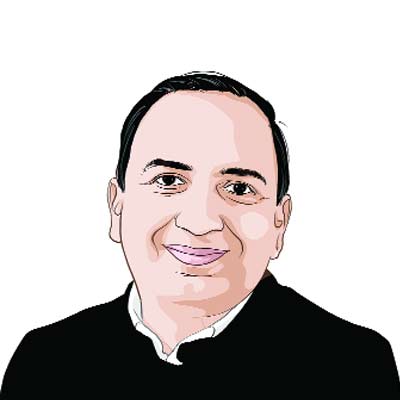End of anti-corruption?
Its politics is confined to a slash and burn exercise, only useful for knocking down opponents

Concerns over corruption now have a much steeper hill to climb. Its very absence as a big political issue is a sign of its power. (Representational image)
In 2014, plutocracy and corruption were two big themes that defined Indian politics. The discourse of anti-corruption, and the inability of the UPA to respond to it effectively, delegitimised the Congress to an unprecedented degree. What is going to be the fate of anti-corruption politics in India? Is it at a dead end?
At one level, corruption is back as a political issue. The Rafale controversy is a start. Given our track record, it is hard to see a decisive closure on the issue. The Supreme Court has now got into the act of looking into the issue of the price of the deal. But very frankly, the price issue on its own is not enough grist for the corruption mill. What gives the controversy power is the charge of favouritism. But the allegations have achieved this much. It has become the focal point that neutralises the BJP’s perceived advantage on the corruption issue. The Congress may not have a leg to stand on when it comes to corruption.
The fires that fuelled the anti-corruption movement had something genuine to them, and many of its leading lights do not have the imprimatur of credibility. But it was politically important for the Congress to at least take the sheen off the BJP’s claim that corruption has become a non-issue. All it had to do was sow the seeds of doubt. Rafale has, to some extent, done just that. On corruption, even a draw is a victory for the Opposition. Second, it has thrown the spotlight on the issue plutocracy: Whether or not money changed hands is one question, but the enduring power of particular business houses still requires explanation.
But in some senses, concerns over corruption now have a much steeper hill to climb. Its very absence as a big political issue is a sign of its power. Some have to do with the institutional features that make plutocracy now even more entrenched than five years ago. There was, as this column had argued, at the time, a lot of irresponsible excess in the anti-corruption movement. But at least that movement had taken place in the context of a democratic energy. That democratic energy was fuelled by two forces: A relatively free media that felt free to turn the spotlight on corruption, perhaps to the point where it sometimes undermined its own credibility. But the ability to keep the corruption issue on the back burner in the media is not a sign of a cleaner government: It should be seen as a sign that the power of plutocracy has grown to the point that it has become nearly impossible to have the kind of democratic discussion necessary for the subject. When the dogs are not allowed to bark, it is a surer sign that plutocracy is more entrenched than when dogs were barking freely.
Second, the anti-corruption movement had relied on partners in the state. But the voice and credibility of independent institutions like the CAG has become muted and less effective. This is so for two reasons. The conduct of many erstwhile anti-corruption warriors, post retirement, in joining hands with this government has made it more difficult for their successors to garner credibility. It is, in retrospect, easy to paint so much of what the CAG did under UPA 2 as part of a political conspiracy; anti-corruption became someone’s ticket to limelight and power. In UPA 2 the political class lost control over the government; in this regime the stranglehold on government is such that even routine accountability functions might become difficult. So it will take officers and institutions with even rarer courage and credibility to provide more ammunition to concerns over corruption.
There is, rightfully, more scepticism about what an anti-corruption politics achieved. The crescendo of public energy in 2014 has not led to any institutional regeneration. Quite the contrary. The credibility of all institutions of accountability from the CVC to CBI, judiciary to police, is in worse shape than five years ago. In short, the instruments of following through on anti-corruption politics simply do not exist; indeed, the fear that they will be misused is now more pronounced than the confidence that they can be instruments of accountability. There is also now, not without justification, the fear that an insistent anti-corruption politics, in the absence of institutional sophistication and a more complex public discourse, is simply a recipe for economic slow-down rather than regeneration. We had barely recovered from Bofors having grounded defence procurement; it is not an unfounded fear that this is exactly what Rafale will also do.
But more broadly, one day the full history will be written on the ways in which half-baked and knee jerk anti-corruption measures of the kind even the Supreme Court crafted had serious cascading effects on the economy: The economy could neither endure corruption nor the means deployed to overcome it. From banking to real estate, we are still dealing with a log jam.
Finally, there is the lasting effect of demonetisation. Demonetisation was sold as an anti-corruption measure, a nuclear option that would set India on the path of regeneration. Instead this ill-advised measure only produced significantly lasting pain, short changed small and medium enterprises and ordinary citizens. It was more about throwing dust in people’s eyes, while the essential structure of plutocracy remained intact. In part, the failure of that enterprise has underscored one point that should have been obvious to anyone: There is no single focal point action or silver bullet that can alone tackle the corruption problem. Building anti-corruption institutions that are sensible and fair is a long process. But it is really difficult to politically mobilise around the arduous task of institution building. So most anti-corruption politics will remain confined to a slash and burn exercise, useful for knocking down opponents, but with no lasting impact on the sinews of power.
It is difficult for genuine anti-corruption politics to find space in the absence of a credible agent of such a politics, support from key state institutions, free media, and scepticism about what it achieves. So anti-corruption will remain a politically alive issue, for all parties to score points and neutralise each other’s advantage. But there is no serious anti-corruption movement or pathway left. Plutocracy still rules.
The writer is vice-chancellor of Ashoka University. (Views are personal)
For all the latest Opinion News, download Indian Express App
More From Pratap Bhanu Mehta
- The Lies That Bind book review: The Crisis of IdentityThat which defines is also that which reduces, writes Kwake Anthony Appiah in a deeply perceptive analysis of the problematics of selfhood..
- A darkening horizonAs the liberal order declines, a polarised world full of majoritarian, intellectually insecure angst looms...
- The Sabarimala aftermathCourt authority is imperilled, parties have rallied behind orthodoxy, there is political fishing in troubled waters ..







































No hay comentarios:
Publicar un comentario